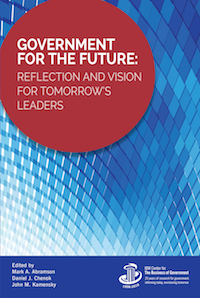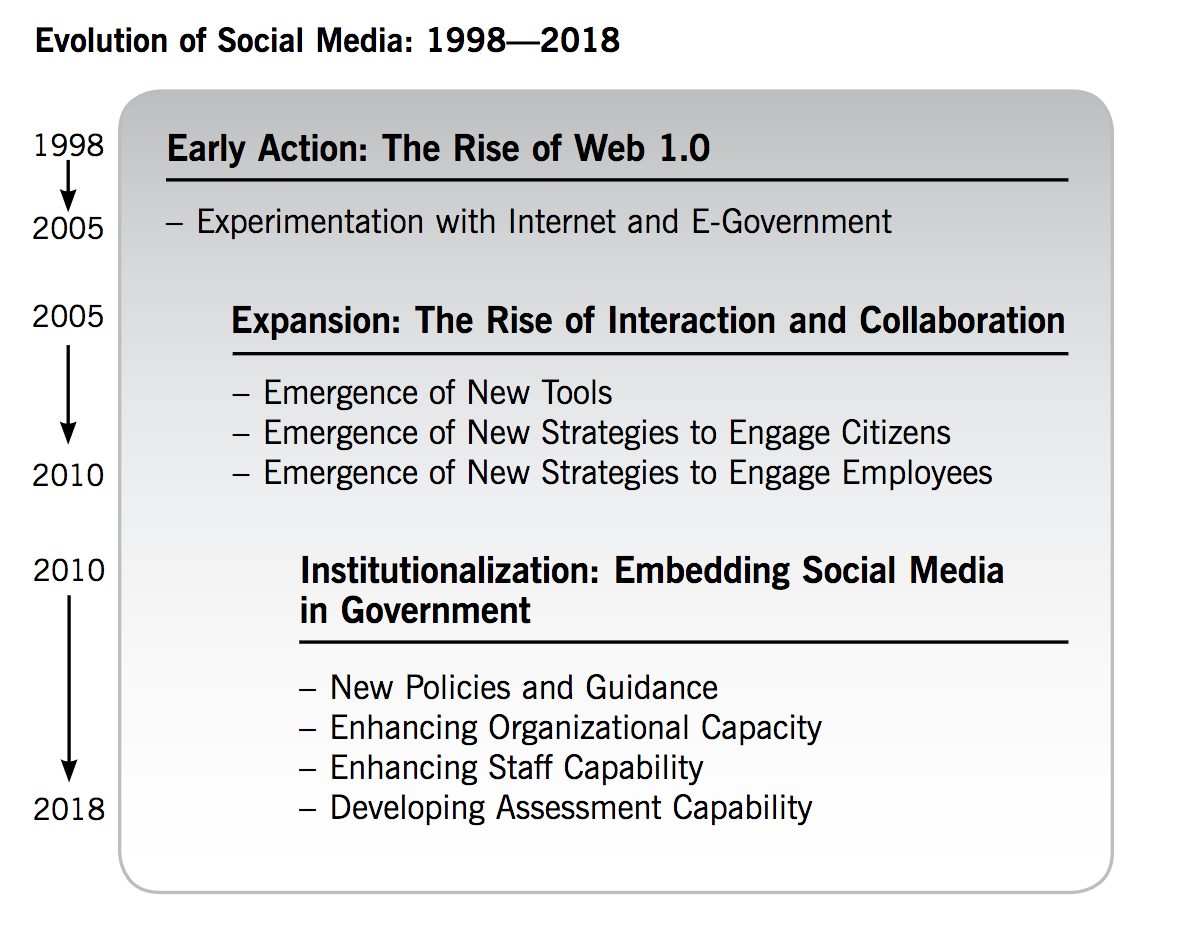
Government Reform Over the Past 20 Years -- Part 4, The Evolution of Social Media in Government

In the IBM Center’s new book, Government For The Future: Reflection and Vision for Tomorrow’ Leaders, we have identified six major trends that have driven government management reforms. This is the fourth in a six-part series where we highlight each trend; part five summarizes the evolution of the use of social media by government. For more detail, see the chapter on Social Media.
To appreciate the growth of social media, one only has to look back to 1998. At that point, the internet (then more commonly called the World Wide Web) was just five years old, the creation of Facebook was still six years away (2004), and the creation of Twitter eight years away (2006). Today, the impact of social media is clearly seen at all levels of government.
Social media is commonly defined as computer-assisted technologies that facilitate the creation and sharing of information via virtual communities and networks. At the federal level, nearly all agencies now invite citizens to “connect with us” on a vast array of social media platforms, including Facebook, Twitter, Instagram, YouTube, Flickr, Pinterest, LinkedIn, Digg, and Google+. In addition, nearly all agencies have internal social media platforms that encourage greater communication and engagement with employees.
Social media offers the government a new set of tools and platforms in which to both inform and engage the public. The quest for meaningful citizen engagement has been long been a public sector goal. In the past, this quest largely focused on face-to-face engagement. For example, town hall meetings have been a staple of American government dating back to colonial times. In addition to attending meetings, citizens have had the option of visiting a government office. If an individual could not physically attend a face-to-face meeting to either gain information or comment on government activity, citizen engagement was limited to either writing a letter to a government official or agency, or simply reading about a government action in a newspaper or an official notice from government (usually delivered through the mail).
Background: The Evolution of Social Media
Progress in this area has moved through three major phases over the past 20 years, as shown in the following chart:
- Early Action: This phase was characterized by government’s experimentation with the internet and the development of websites which were static and non-interactive. This early period saw new ways to engage citizens undertaken and assessed.
- Expansion: The decade of the 2000s was characterized by the rapid expansion of the number of websites across government, as well as the emergence of new tools, such as blogs—and new platforms, including Facebook, Twitter, and Instagram. During the expansion period, new strategies for engaging citizens and civil servants were deployed. This period was also characterized by the identification of barriers which hindered further expansion of the use of social media by government agencies.
- Institutionalization: The decade of the 2010s can be characterized by the institutionalization of social media, in which barriers were overcome by the development of new policies and guidance, enhancing organizational and staff capacity, and developing assessment capability.
Lessons Learned and Looking Forward
Based on our review of research on this topic over the past twenty years, we identified four key lessons:
First, as with any innovation, government agencies can be divided between innovators, early adopters, and laggards. Innovators and early adopters have a special role to play in implementing future social initiatives. Innovative agencies need to be recognized, rewarded, and encouraged to share their knowledge and experience with agencies moving more slowly along the adoption curve.
Second, agencies can become more effective and improve their performance by engaging the public through social media. By engaging citizens through social media, agencies can obtain crucial feedback on current performance and how their performance could be improved. Such engagement can also assist government organizations in developing clearer and more effective policies.
Third, the role of interagency communities of practice helps with the successful implementation of social media initiatives. Central management agencies can take responsibility for catalyzing and encouraging communities of practice on new management initiatives. The creation of interagency communities of practice serve two primary purposes:
- Providing a vehicle for agencies to share their experiences of what has worked well and what has not
- By sharing information and participating in a government-wide initiative, agencies begin to take ownership of a given initiative
Fourth, interagency communities of practice can play a key role in identifying government-wide policy changes needed in response to a new initiative. In the case of social media, a host of government-wide policies required change or updates to reflect the use of new social media tools.
As agencies continue to develop their social media capabilities and strategies while expanding internal and public use, they will need to focus on several areas:
- Managing the evolving risks associated with social media: The government needs to develop policies, practices, and approaches for creating and maintaining trust when citizens interact with agencies on social media platforms. This will include attention to privacy and security issues related to users’ identities, as well as tracking individual users across platforms to create integrated profiles of their interactions.
- Managing the increasing convergence of the uses of social media: Social media tools and platforms will increasingly provide the foundation for new forms of collaboration and engagement among agencies and between government and citizens. These new models of interaction could serve as powerful accelerators for how government works in the future.
- Improving the user experience with social media: The user experience is defined as the overall experience of an individual with using a product, such as a website or platform. The federal government will need to focus in the future on improving user experiences for:
- Citizens: Government agencies now involve citizens in testing new platforms to make them easier to use, to increase customer satisfaction.
- Government employees: The user experience by government employees is also crucial in that employees now seek a more consistent experience in working across multiple platforms to better serve citizens. An emphasis on the employee user experience will increase the adoption rate of social media as “the way of doing business” in government.
Addressing these opportunities will set the stage for longer-term innovations and increased adoption of social media strategies in government.




